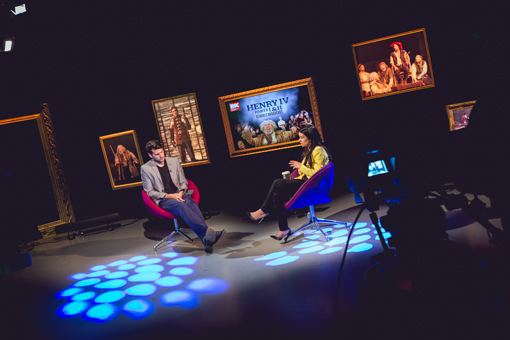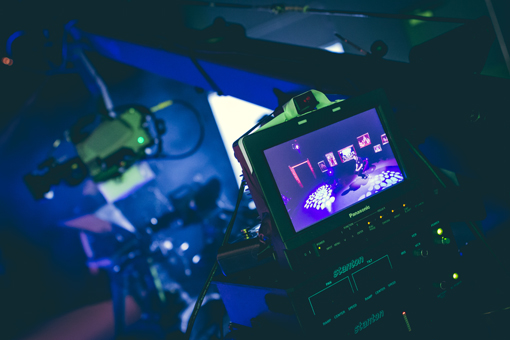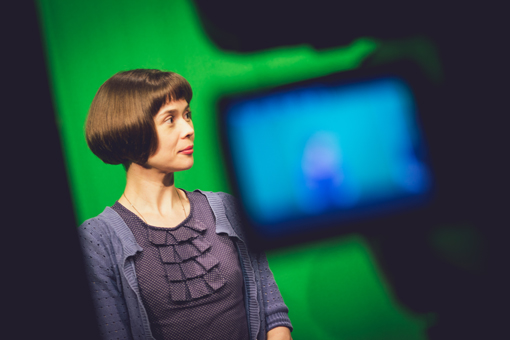Taryn Storey looks behind the scenes of a digital collaboration between the Royal Shakespeare Company (RSC) and Ravensbourne College.
About the Author: Dr Taryn Storey was appointed Higher Education Programme Developer at the Royal Shakespeare Company in July 2015. She has recently completed an AHRC funded PhD at University of Reading on New Writing Development in Post-War British Theatre, and has taught Drama at the Universities of Worcester, Reading, Bedford and Oxford Brookes University. She has previously worked as an Education Associate Practitioner at the RSC, as Youth Arts Co-ordinator at Pegasus Theatre in Oxford, and as Creative Director of a major project at the Theatre Museum (Victoria and Albert Museum) in London.

© Jamie Morris / Ravensbourne College
It is 9.00am on the 15th November 2013. As 31,000 school children throw down their bags and take their seats in classrooms across Britain, actor David Tennant, and the RSC’s Artistic Director Gregory Doran, are being rushed from Stratford Upon Avon to a TV studio in South London. Waiting to greet them is TV presenter Konnie Huq. They are about to embark on a unique educational journey: an interactive live streaming of the Royal Shakespeare Company’s production of Shakespeare’s Richard II. At 9.15am the broadcast goes live. It is the first time 87% of the children watching will have seen an RSC production, and the first time 57% of them will have seen a Shakespeare play.[i] But this is to be far from a simple screening of the production: it is an opportunity for school students across the UK to interact with the director and lead actor in real time. Welcome to Shakespeare’s biggest classroom.
The RSC’s free Schools’ Broadcasts began in 2012 as part of the aspirations of the theatre company to use digital technology to increase their audience reach, and to create exciting and innovative approaches to young people’s first encounters with Shakespeare. The Broadcasts have developed through a unique collaboration between the RSC’s Education Department and students of Ravensbourne College in London, and provide an example of how the arts and cultural sector can work directly with Universities in the development of technological and pedagogic innovation.
Increasing the links between the academic community and the creative industries has been the subject of two recent reports by Universities UK (2014) and the Arts and Humanities Research Council (2015). These reports argue that collaboration is crucial in terms of training graduates entering the workplace - providing ‘a valuable tool for building higher level skills’[ii] and enabling the development of ‘creative human capital’ [iii] However, the RSC/Ravensbourne collaboration is not just a training ground for future workers within an industry, it has delivered bespoke technology that has developed the way in which the RSC engages with its audiences and provides meaningful connections with young people, and has developed the pedagogy of both partner organisations. As such, it is an excellent example of a meeting point between the HE sector and the Cultural sector that creates what Comunian & Gilmore describe as a ‘third space’[iv] which offers ‘more organic models of engagement where knowledge can be co-created and developed across and beyond academia.’ [v] It is also an example of how investment in innovative technology within the arts sector can open the doors to new audiences.
...an example of how investment in innovative technology within the arts sector can open the doors to new audiences.
The collaboration between the Royal Shakespeare Company and students from Ravensbourne College was originally initiated in late 2011 as a legacy project for the 2012 Cultural Olympiad. RSC Education commissioned theatre-maker Tim Crouch to create a new play for young people (I, Cinna, The Poet) based on the story of the poet in Julius Caesar. This was to accompany Gregory Doran’s production of Julius Caesar for the RSC’s main stage.
‘The RSC, Cisco and Ravensbourne wanted to find a way of streaming the production online in a way that felt as close as possible to a theatrical experience. We knew we didn’t want to produce a downloadable film. We wanted to create a real time event online that enabled all participants to be part of the same experience, just as a theatre audience are. The original concept was to film the performance live from the Swan theatre, but we didn’t have the capacity in our schedules to make this possible. So instead, Ravensbourne put together an outside broadcast team and we filmed I, Cinna on location in London. Another group of students then created the platform that the film would be streamed through and a third group of students ran the live studio element.’[vi]
On the 2 July 2012, I, Cinna was streamed live to schools across the UK (via service provider Janet) as part of a live event which included a studio discussion between I, Cinna director and writer Tim Crouch, actor Jude Owusu, and children’s author Malorie Blackman. Watched by 9,000 children it received positive feedback from teachers who reported that the event was not just beneficial to learning but had also been extremely enjoyable.
Teachers around the UK expressed a strong interest in future projects. For the RSC Education team it had been a hugely ambitious project that meant they were grappling not just with developing an interactive online platform, but also filming a production on location with students in all the lead creative roles working alongside professional artist Tim Crouch.

© Jamie Morris / Ravensbourne College
In January 2012, Gregory Doran was appointed as the RSC’s new Artistic Director. One of his first innovations was to develop the RSC Live from Stratford broadcasts whereby productions of RSC plays are streamed live into UK Cinemas. Over the next six years this footage will provide RSC Education with high quality film recordings of every play in the Shakespeare canon. The first of these, David Tennant’s Richard II, was broadcast in 2013, and RSC Education once again invited Ravensbourne to be partners in the creation of their schools broadcast. Two Ravensbourne students, Jon Lambert and Sean Mhemet, were keen to enhance the experience of the previous broadcast and began to develop an interactive platform that was more effective at fulfilling the original aim of enabling everyone participating in the broadcasts to feel like they were in the same room together. They created a new microsite and web interface for the live studio Q and A:
‘The students replicated standard industry practice by producing iterated wireframes and proto-type sites, as well as attending client meetings with the RSC in Stratford-upon-Avon. Feedback from in house designers at the RSC was integrated into the site production, again replicating standard industry practice until the final site design was agreed upon. The site was a flat, full-width, single page design that echoed extremely fashionable ‘infinite parallax scrolling’ genre. It was a commendable example of contemporary web design, visually equal to the best commercial productions of the time.’[vii]
On the 15th November the new technology went live. As David Tennant and Gregory Doran were arriving in the studio, students began to submit questions to them via the web. These appeared as a ticker stream in a control room where RSC staff selected key questions and fed them through to Konnie Huq in the studio, trying to ensure a varied selection of questions from each of the participating schools. The studio event was run by 15 students from Ravensbourne’s Broadcast courses:
‘Multiple cameras were used in the studio, giving a number of budding camera operators the opportunity to put their skills into practice. Live sound was key, giving students in this area a similar opportunity, with lighting also an important consideration. The studio feeds were mixed in Ravensbourne’s state of the art control room, where students developing this skills set were able to engage in vision mixing and ensure the quality of the delivery, as well as adding graphic to the feed where necessary. A dedicated team ensured that the video was encoded and delivered via the Internet in a reliable, and high-quality form, which will be an increasingly important mechanism for TV in the coming decades.’[viii]
Young people were also asked to send in pictures of themselves which were uploaded onto the screen. Fiona Ingram, Head of Education programmes at the RSC, described the School’s Broadcast of Richard II as ‘a big learning curve for both the RSC and the students from Ravensbourne. Everybody was learning together. We initially had no idea what capacity we would need.’ As Fiona, and James Morris course leader at Ravensbourne, have both separately acknowledged, with a live audience of 30,000 people there was no room for failure.
...‘It was a case of ‘if you can’t come to us, then we are coming to you’
The RSC Schools’ Broadcasts have been greeted with much enthusiasm by students and teachers around the country. One teacher wrote:
‘It was a case of ‘if you can’t come to us, then we are coming to you’ and gave our kids the opportunity to see the RSC for the first time in their lives … the interview with David and Greg was excellent and clearly gave schools the opportunity to access the creative heart of the production – instead of being outside looking in, noses pressed against the window pane, the window was opened and we felt like we were in the room.’[ix]

© Jamie Morris / Ravensbourne College
For the RSC the benefit of the collaboration is twofold: it has opened the door to new ways of engaging young people with Shakespeare’s works and has generated new audiences for the company’s work. Over 70,000 young people watched the latest broadcast and 82% of schools said that as a result of the broadcast they would now consider taking children to see an RSC production in a theatre.
‘The Schools’ Broadcasts series has become a central part of the RSC’s Education programme. It has enabled us to reach more schools and students than ever before, bringing the highest quality experiences of Shakespeare’s work in performance into classrooms across the UK. It is a clear example of the vital inter-relationship that exists between the arts and technology, where each achieves greater reach, relevance and creativity by the contribution of the other.’ [x] The RSC and Ravensbourne have, to date, collaborated on a total of seven Schools’ Broadcasts: I, Cinna, Richard II, Henry IV parts I & II, The Two Gentleman of Verona, Love’s Labour’s Lost, and Love’s Labour’s Won (Much Ado About Nothing). After each broadcast the interactive package for schools has been refined and developed. The footage from the RSC Live performances is now repurposed for schools, and spilt into three sections to suit the needs of an online, ‘first time’ audience - with intervals for break and lunch time. Between each section animations are streamed to enable young audiences to see a synopsis of what will happen next in the story. Images of the characters are shown to introduce who’s who, and an assistant director in the studio guides the young audience by describing what to look out for in the next section of the play. The aim is to make the broadcasts as engaging as possible and offer a variety of resources for teachers (targeted from primary through to A level). The RSC is keen that their future Schools’ Broadcasts of Henry V, (19th November 2015), Othello (17th March 2016), and The Merchant of Venice (21st April 2016), will continue to refine the experience for students, and plans are afoot to introduce outside broadcasts from participating schools, to enable students from around the country to talk directly to each other.
The RSC is now working with the University of the First Age to develop a Young Researchers’ group made up of young people from participating schools across the UK. They will be trained in research methods and will inform the future development of the Schools’ Broadcasts, starting with Henry V.
For Ravensbourne students Jon and Sean the collaboration has provided a direct entry into postgraduate employment: they have recently been employed by the RSC to create a microsite to support the RSC’s 2016 production of A Midsummer Night’s Dream/Play for a Nation, with a cast of fourteen amateur theatre companies and 580 fairies from schools around the UK. They are in the process of creating a web-based platform to enable the rehearsal process to be streamed live from the RSC’s rehearsal rooms in Stratford Upon Avon to participating groups.
The RSC/Ravensbourne collaboration continues to be truly innovative - enabling the RSC to constantly refine and develop the way in which it connects to schools’ audiences, whilst also developing new technology that has opened up the possibilities for the way in which the company rehearses and produced new work in collaboration with key partners around the country.
Taryn Storey, Higher Education Programme Developer, Royal Shakespeare Company.

© Jamie Morris / Ravensbourne College
Footnotes
[i] Richard II Schools’ Broadcast (2013), RSC Education Research, Stratford Upon Avon: unpublished.
[ii] CFE Research (2014), Forging Futures: Building Higher level Skills through University and Employer Collaboration. London: Universities UK, p.8. (http://www.universitiesuk.ac.uk/highereducation/Documents/2014/ForgingFutures.pdf, accessed online 7 August 2015.
[iii] Comunian, T., & Gilmore, A., (2015), Beyond the Creative Campus: Reflections of the evolving relationship between higher education and the creative economy, London: King’s College, p.7. London.https://kclpure.kcl.ac.uk/portal/files/38977024/Beyond_the_Creative_Campus_Comunian_Gilmore_2015.pdf, accessed online 7 August 2015.
[iv] ibid
[v] ibid
[vi] O’Hanlon, J., RSC Director of Education
[vii] Morris, J., (2015), Shakespeare’s Biggest Classroom And The Future of Heritage Online , unpublished paper, p.6.
[viii] Ibid p.11
[ix] Unnamed Teacher, (2013), Richard II Schools’ Broadcast, op cit..
[x] O’Hanlon, J., RSC Director of Education.
Bibliography
CFE Research (2014), Forging Futures: Building Higher level Skills through University and Employer Collaboration. Universities UK, (http://www.universitiesuk.ac.uk/highereducation/Documents/2014/ForgingFutures.pdf, accessed online 7 August 2015.
Comunian, T., & Gilmore, A., (2015), Beyond the Creative Campus: Reflections of the evolving relationship between higher education and the creative economy, London: King’s College, p.7. London.https://kclpure.kcl.ac.uk/portal/files/38977024/Beyond_the_Creative_Campus_Comunian_Gilmore_2015.pdf, accessed online 7 August 2015.
Morris, J., (2015), Shakespeare’s Biggest Classroom And The Future of Heritage Online, unpublished paper.
Richard II Schools’ Broadcast (2013), RSC Education Research, Stratford upon Avon: unpublished.